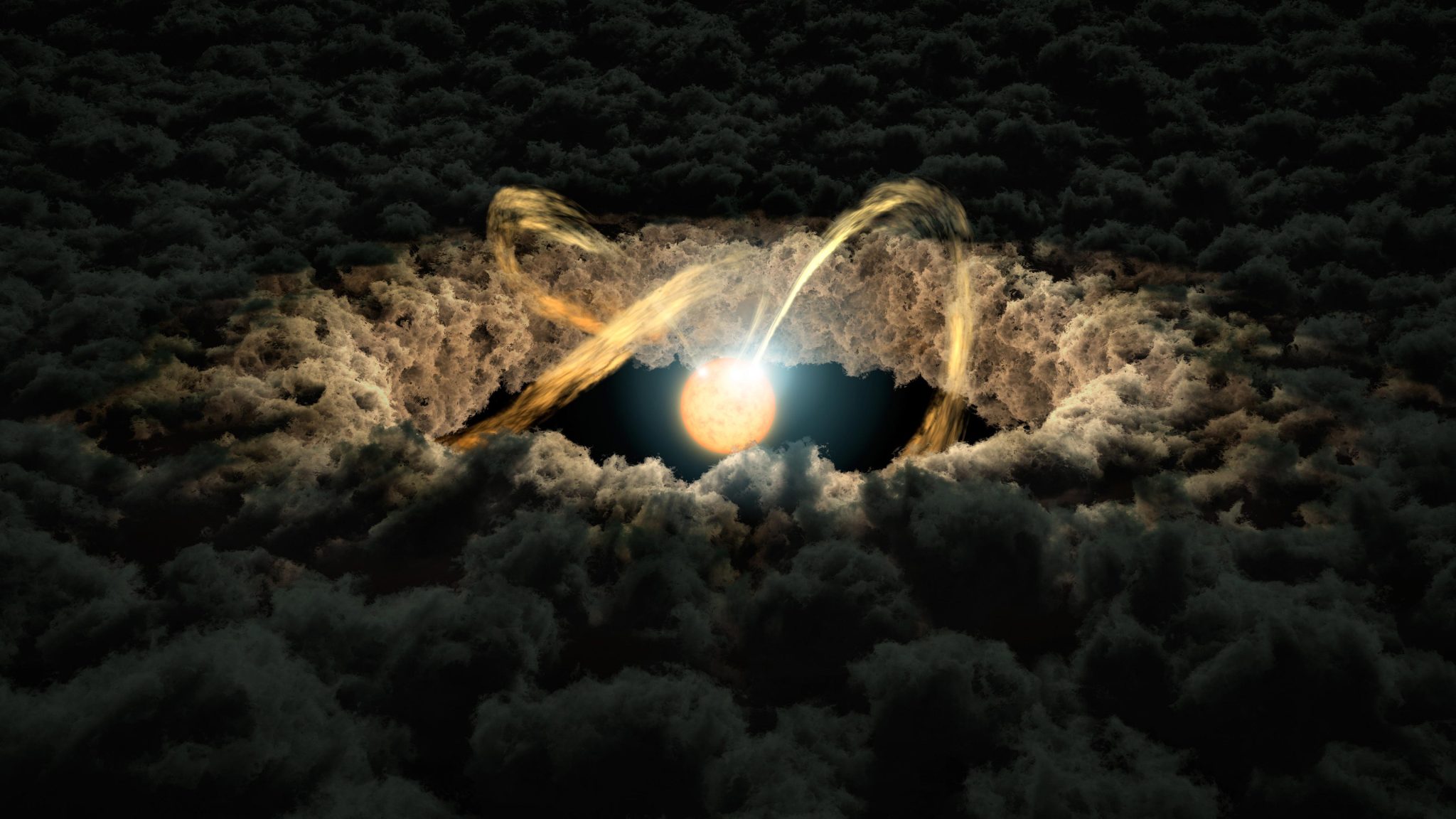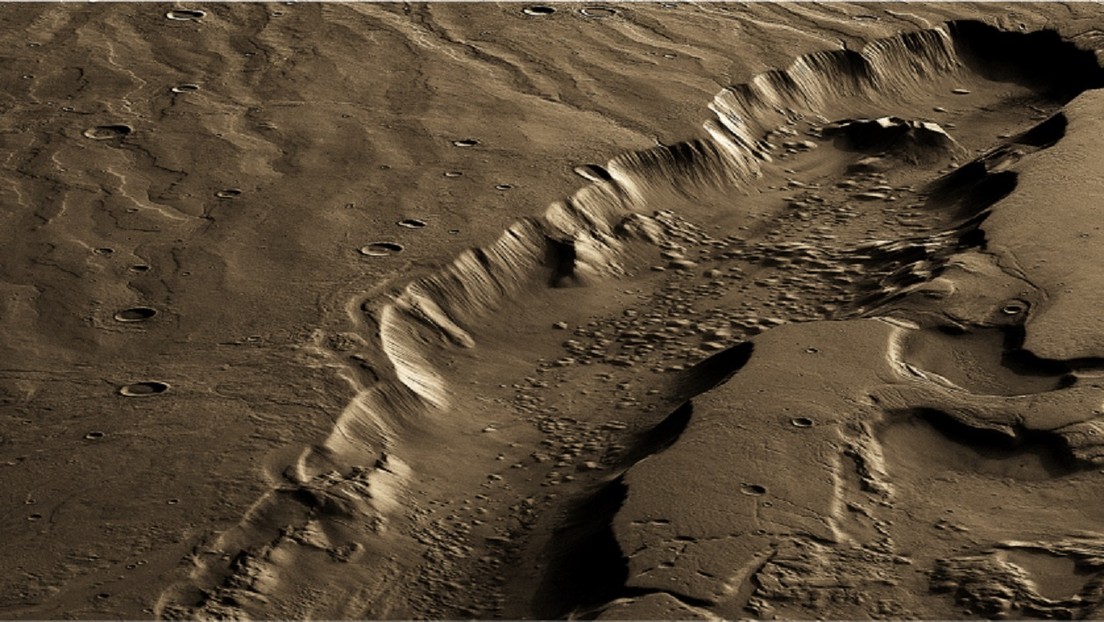Los astronautas de la NASA llegan para el primer vuelo espacial tripulado de Boeing
Horoscopo
Inestabilidad en el Sistema Solar Temprano – Implicaciones para el Misterioso «Planeta 9»

Todas las estrellas, incluido nuestro sol, nacen de una nube de polvo y gas. Esta nube también puede sembrar planetas que orbitarán alrededor de la estrella. Crédito: NASA/JPL-Caltech
La inestabilidad al comienzo del sistema solar.
Una nueva explicación de por qué nuestro sistema solar es como es, y por qué otros también lo son.
Seth Jacobson, de la Universidad Estatal de Michigan, y sus colegas en China y Francia han revelado una nueva teoría que podría ayudar a resolver un misterio galáctico sobre la evolución de nuestro sistema solar. Específicamente, cómo los gigantes gaseosos…[{» attribute=»»>Jupiter, Saturn, Uranus, and Neptune — end up where they are, orbiting the sun like they do?
The findings have ramifications for how terrestrial planets like Earth developed, as well as the possibility that a fifth gas giant planet lurks 50 billion miles out into the distance.
“Our solar system hasn’t always looked the way that it does today. Over its history, the orbits of the planets have changed radically,” said Jacobson, an assistant professor in the College of Natural Science’s Department of Earth and Environmental Sciences. “But we can figure out what’s happened.”

An artist’s rendering shows a hypothetical early solar system with a young star clearing a path in the gas and dust left over from its formation. This clearing action would affect the orbits of gas giants orbiting the star. Credit: NASA/JPL-Caltech/T. Pyle (SSC)
The research, published in the journal Nature on April 27, 2022, offers an explanation for what happened to gas giants in other solar systems and ours.
It’s a Nice model
Massive, whirling clouds of cosmic gas and dust give birth to stars. The early solar system was still filled with a primordial disk of gas when our sun ignited, and it played an important role in the formation and evolution of the planets, including the gas giants.
In the late 20th century, scientists began to believe that the gas giants initially circled the sun in neat, compact, uniformly spaced orbits. Jupiter, Saturn, and the others, however, have long settled into orbits that are relatively oblong, misaligned, and spread apart.
So the question for researchers now is, why?
In 2005, an international team of scientists proposed an answer to that question in a trio of landmark Nature papers. The solution was originally developed in Nice, France and is known as the Nice model. It posits that there was an instability among these planets, a chaotic set of gravitational interactions that ultimately set them on their current paths.
“This was a tectonic shift in how people thought about the early solar system,” Jacobson said.
The Nice model remains a leading explanation, but over the past 17 years, scientists have found new questions to ask about what triggers the Nice model instability.
For example, it was originally thought that the gas giant instability took place hundreds of millions of years after the dispersal of that primordial gas disk that birthed the solar system. But newer evidence, including some found in moon rocks retrieved by the Apollo missions, suggests it happened more quickly. That also raises new questions about how the interior solar system that’s home to Earth evolved.
Working with Beibei Liu from Zhejiang University in China and Sean Raymond from the University of Bordeaux in France, Jacobson has helped find a fix that has to do with how the instability started. The team has proposed a new trigger.
“I think our new idea could really relax a lot of tensions in the field because what we’ve proposed is a very natural answer to when did the giant planet instability occur,” Jacobson said.
The new trigger
The idea started with a conversation Raymond and Jacobsen had back in 2019. They theorized the gas giants may have been set on their current paths because of how the primordial gas disk evaporated. That could explain how the planets spread out much earlier in the solar system’s evolution than the Nice model originally posited and perhaps even without the instability to push them there.
“We wondered whether the Nice model was really necessary to explain the solar system,” Raymond said. “We came up with the idea that the giant planets could possibly spread out by a ‘rebound’ effect as the disk dissipated, perhaps without ever going unstable.”
Raymond and Jacobsen then reached out to Liu, who pioneered this rebound effect idea through extensive simulations of gas disks and large exoplanets — planets in other solar systems — that orbit close to their stars.
“The situation in our solar system is slightly different because Jupiter, Saturn, Uranus and Neptune are distributed on wider orbits,” Liu said. “After a few iterations of brainstorm sessions, we became aware that the problem could be solved if the gas disk dissipated from the inside out.”
The team found that this inside-out dissipation provided a natural trigger for the Nice model instability, Raymond said.
“We ended up strengthening the Nice model rather than destroying it,” he said. “This was a fun illustration of testing our preconceived ideas and following the results wherever they lead.”
With the new trigger, the picture at the beginning of the instability looks the same. There’s still a nascent sun surrounded by a cloud of gas and dust. A handful of young gas giants revolve around the star in neat, compact orbits through that cloud.
“All solar systems are formed in a disk of gas and dust. It’s a natural byproduct of how stars form,” Jacobson said. “But as the sun turns on and starts burning its nuclear fuel, it generates sunlight, heating up the disk and eventually blowing it away from the inside out.”
This created a growing hole in the cloud of gas, centered on the sun. As the hole grew, its edge swept through each of the gas giants’ orbits. This transition leads to the requisite giant planet instability with very high probability, according to the team’s computer simulations. The process of shifting these large planets into their current orbits also moves fast compared with Nice model’s original timeline of hundreds of millions of years.
“The instability occurs early as the sun’s gaseous disk dissipated, constrained to be within a few million years to 10 million years after the birth of the solar system,” Liu said.
The new trigger also leads to the mixing of material from the outer solar system and the inner solar system. The Earth’s geochemistry suggests that such a mixing needed to happen while our planet is still in the middle of forming.
“This process is really going to stir up the inner solar system and Earth can grow from that,” Jacobson said. “That is pretty consistent with observations.” Exploring the connection between the instability and Earth’s formation is a subject of future work for the group.
Lastly, the team’s new explanation also holds for other solar systems in our galaxy where scientists have observed gas giants orbiting their stars in configurations like what we see in our own.
“We’re just one example of a solar system in our galaxy,” Jacobson said. “What we’re showing is that the instability occurred in a different way, one that’s more universal and more consistent.”
Planet 9 from outer space
Although the team’s paper doesn’t emphasize this, Jacobson said the work has implications for one of the most popular and occasionally heated debates about our solar system: How many planets does it have?
Currently, the answer is eight, but it turns out that the Nice model works slightly better when the early solar system had five gas giants instead of four. Sadly, according to the model, that extra planet was hammer-thrown from our solar system during the instability, which helps the remaining gas giants find their orbits.
In 2015, however, Caltech researchers found evidence that there may yet be an undiscovered planet tooling around the outskirts of the solar system some 50 billion miles from the sun, about 47 billion miles farther out than Neptune.
There’s still no concrete proof that this hypothetical planet — nicknamed Planet X or Planet 9 — or the Nice model’s “extra” planet actually exist. But, if they do, could they be one and the same?
Jacobson and his colleagues couldn’t answer that question directly with their simulations, but they could do the next best thing. Knowing their instability trigger correctly reproduces the current picture of our solar system, they could test whether their model works better starting with four or five gas giants.
“For us, the outcome was very similar if you start with four or five,” Jacobson said. “If you start with five, you’re more likely to end up with four. But if you start with four, the orbits end up matching better.”
Either way, humanity should have an answer soon. The Vera Rubin Observatory, scheduled to be operational by the end of 2023, should be able to spot Planet 9 if it is out there.
“Planet 9 is super controversial, so we didn’t stress it in the paper,” Jacobson said, “But we do like to talk about it with the public.”
It’s a reminder that our solar system is a dynamic place, still full of mysteries and discoveries waiting to be made.
Reference: “Early Solar System instability triggered by dispersal of the gaseous disk” by Beibei Liu, Sean N. Raymond and Seth A. Jacobson, 27 April 2022, Nature.
DOI: 10.1038/s41586-022-04535-1

Experiencia en periódicos nacionales y periódicos medianos, prensa local, periódicos estudiantiles, revistas especializadas, sitios web y blogs.
Horoscopo
El cuarteto copia el espacio en Clark para convertirse en el Centro de Aprendizaje Judío Jabad de Evanston
En algún momento antes de septiembre, el espacio de 2,300 pies cuadrados en 825 Clark St., anteriormente ocupado por Quartet Copies, probablemente volverá a estar lleno de actividad como el Centro de Aprendizaje Judío Jabad de Evanston.
En una llamada telefónica, el rabino Meir Hecht de Jabad de Evanston confirmó que Jabad compró el espacio a principios de 2024.
Espacio de aprendizaje y biblioteca abiertos al público.
Charles Davidson de Charles Davidson Group presentó la solicitud de análisis de zonificación en línea el 25 de febrero y la solicitud fue aprobada el 11 de marzo.
La solicitud incluía una carta de Hecht, como director de la Fundación de Aprendizaje Judío, que indicaba que el futuro centro de aprendizaje ofrecería clases para adultos diarias y nocturnas, una escuela hebrea para niños los domingos por la mañana, un salón después de la escuela para adolescentes, un salón después de la escuela. un programa de escuela de artes hebreas y una biblioteca abierta de domingo a jueves.
Actualmente, estas actividades se llevan a cabo en los hogares de las personas, en la Universidad Northwestern o en el Centro Comunitario Fleetwood-Jourdain. Hasta la pandemia, el programa de arte extraescolar se llevaba a cabo en las escuelas del Distrito 65. Hecht dijo que está ansioso por ponerlo en marcha nuevamente.
Los servicios de adoración se llevarían a cabo el viernes por la noche y el sábado por la mañana, así como durante los días festivos religiosos. Jabad Evanston ya cuenta con un espacio abierto y sin renovar para séders, almuerzos y servicios de Pesaj, dijo Hecht.
«Además, proporcionaremos a la comunidad una extensa biblioteca judía abierta al público para estudiar y leer», escribió Hecht. “La biblioteca y la sala de estudio/lectura serán un espacio acogedor para los miembros de la comunidad de todas las edades a diario.
“Esperamos que este nuevo centro de aprendizaje judío sea un faro de luz para toda la comunidad de Evanston. Todos son bienvenidos”, dijo Hecht.
En el sitio web de Quartet, la compañía ofreció la siguiente explicación sobre su salida en junio de 2023: “Actualmente estamos en el proceso de mudarnos de la ubicación de Evanston. Los propietarios están buscando un área comercial/industrial donde podamos continuar sirviendo a nuestros clientes de Chicago. En este momento busque imprentas locales.

Experiencia en periódicos nacionales y periódicos medianos, prensa local, periódicos estudiantiles, revistas especializadas, sitios web y blogs.
Horoscopo
Comparación de la tripulación comercial Boeing Starliner y SpaceX Dragon de la NASA

Uno de ellos ya ha transportado a ocho tripulaciones de la NASA y tres tripulaciones privadas a la Estación Espacial Internacional. El otro realizará su primer vuelo con tripulación la próxima semana.
Ambos pueden transportar hasta siete astronautas o una combinación de tripulación y carga. Ambos fueron diseñados para ser lanzados sobre cohetes y perseguir a la Estación Espacial Internacional, viajando a 17.500 mph (200-250 millas) sobre la Tierra, orbitando nuestro planeta cada 90 minutos. Chocamos contra el océano. Las otras “tierras blandas” del desierto.
El objetivo de ambas naves espaciales era encontrar una manera de proporcionar transporte a la ISS para los astronautas de la NASA, ahora que el transbordador espacial de vuelos largos había sido retirado. Ambos fueron seleccionados para recibir financiación pública en 2014 en virtud del contrato de tripulación comercial de la NASA.
Mientras Boeing se prepara para lanzar su cápsula Starliner en su primera misión tripulada a las 10:34 p.m. del 6 de mayo desde el Complejo de Lanzamiento 41 en la Estación Espacial de Cabo Cañaveral, esto es lo que necesita saber sobre Starliner y cómo se compara con SpaceX Dragon.
Boeing Starliner transportará astronautas de la NASA
Boeing lo llama el Transporte espacial de tripulación (CST) -100 Starliner, o simplemente “Starliner”. Su lanzamiento, cuyo lanzamiento está previsto para no antes del 6 de mayo, hará historia como la primera nave espacial en transportar humanos desde el Complejo de Lanzamiento Espacial 41. La plataforma ha sido el sitio de lanzamiento de misiones históricas que comenzaron con los cohetes Titán en 1965 e incluyeron el espacio profundo New Horizons. sonda, la nave espacial Voyager e incluso el rover Curiosity Mars.
Qué se lanza Dónde:Años después del retiro del transbordador espacial, Florida continúa con casi 70 lanzamientos al año
Recientemente se agregó al sitio un brazo de acceso para la tripulación en preparación para la prueba de vuelo con tripulación del Starliner, que se lanzará utilizando un cohete Atlas V ULA (una asociación entre Boeing y Lockheed Martin). El cohete Atlas V se lanza desde este lugar desde 2002, pero esta será la primera vez que llevará astronautas al espacio.
No te pierdas el próximo lanzamiento en Florida:¿Hay lanzamiento hoy? Próximo calendario de lanzamiento de cohetes para SpaceX, ULA y NASA en Florida
Boeing Starliner nombrado Calipso para esta misión
Como parte del Programa de tripulación comercial de la NASA, Boeing pretende que su Starliner transporte regularmente a astronautas de la NASA tras el éxito de esta próxima prueba de vuelo con tripulación. Una vez certificado por la NASA, Starliner se unirá al Dragon de SpaceX, que lleva tripulaciones de la NASA desde 2020. Boeing afirma actualmente que la NASA ha comprado seis misiones tripuladas adicionales más allá de esta próxima prueba de vuelo.
Según Boeing, una cápsula tripulada Starliner puede volar hasta 10 veces, con una vida útil de seis meses entre misiones.
La cápsula que voló el lunes recibió el nombre Calipso por la astronauta Sunita «Suni» Williams. En un guiño a su amor por el océano y la exploración, Williams dijo en 2019 que llamó a la cápsula Calipso después del barco Jacques Cousteau, quien fue un explorador oceánico a mediados del siglo XX. Este barco era conocido por su cámara de observación submarina y su equipo compuesto por un helicóptero y sumergibles, que ayudaban en las expediciones científicas. El comandante de la misión Butch Wilmore volará con Williams.
Boeing Starliner
apellido: Transporte espacial de tripulación (CST) -100 Starliner
Altura: 16,5 pies (cápsula + módulo de servicio)
Diámetro: 15 pies
Tamaño de la tripulación: Cuatro (puede transportar hasta siete)
Cohete: Lanzamiento en ULA Atlas V
Rampa de lanzamiento: Complejo de lanzamiento espacial 41
Reutilizabilidad de cohetes: vuelo único (ULA prueba la reutilización con Vulcan)
Destino: Órbita terrestre e ISS
Aterrizaje: Aterrizando en tierra bajo tres paracaídas y bolsas de aire en el suroeste de Estados Unidos.
Adjudicación del contrato de la NASA (2014): 4.800 millones de dólares
Boeing Starliner, primer atraque sin tripulación
El Starliner de Boeing se acopló con éxito a la Estación Espacial Internacional el 20 de mayo de 2022.
Dragón espacial X

apellido: Cápsula de la tripulación del dragón
Altura: 16 pies
Diámetro: 13 pies
Tamaño de la tripulación: Cuatro (puede transportar hasta siete)
Cohete: Lanzamientos en SpaceX Falcon 9
Rampa de lanzamiento: KSC 39A y Complejo de Lanzamiento Espacial 40.
Reutilizabilidad de cohetes: vuelos múltiples (Falcon 9 aterriza y vuela nuevamente)
Destino: Órbita terrestre e ISS
Aterrizaje: Se estrella en el océano bajo cuatro caídas principales después de usar dos paracaídas estabilizadores
Adjudicación del contrato de la NASA (2014): 3.100 millones de dólares
SpaceX Dragon, primer acoplamiento no tripulado
El SpaceX Dragon se acopló por primera vez a la Estación Espacial Internacional el 25 de mayo de 2012.
Brooke Edwards es reportera espacial de Florida Today. Contáctela en [email protected] o en X: @brookeofstars.

Experiencia en periódicos nacionales y periódicos medianos, prensa local, periódicos estudiantiles, revistas especializadas, sitios web y blogs.
Horoscopo
Los astronautas despegarán desde Cabo Cañaveral en su primer vuelo espacial tripulado en casi 56 años.

TAMPA, Fla. (WFLA) – Por primera vez en más de medio siglo, los astronautas despegarán de la estación espacial en Cabo Cañaveral, Florida, la próxima semana.
Si todo va según lo planeado, la nave espacial Boeing Starliner en un cohete Atlas V se lanzará desde Cabo Cañaveral, lo que será la primera vez que humanos despeguen desde la estación espacial en casi 56 años.
La última vez que se lanzó un ser humano al espacio desde Ciudad del Cabo fue a bordo del Apolo 7 en 1968.
Los dos astronautas de la NASA asignados al primer vuelo espacial tripulado de Boeing, Butch Wilmore y Suni Williams, llegaron a su sitio de lanzamiento la semana pasada, poco más de una semana antes de su despegue programado para el 6 de mayo.
Wilmore y Williams volaron desde Houston al Centro Espacial Kennedy el 25 de abril y servirán como pilotos de pruebas para la cápsula Starliner de Boeing, que hace su debut con tripulación después de años de retrasos.
El Starliner, que despegará el viernes sobre un cohete Atlas, volará a la Estación Espacial Internacional para un crucero de prueba de una semana. Boeing está tratando de alcanzar a SpaceX, que lanza astronautas para la NASA desde 2020.
En los dos vuelos de prueba anteriores del Starliner de Boeing no había nadie a bordo. El primero, en 2019, no he aprobado a la estación espacial debido a problemas de software y otros. boeing repetí la demostración en 2022. Más recientemente, la cápsula era presa por problemas con los paracaídas y cinta inflamable que hubo que retirar.
Wilmore enfatizó que se trataba de un vuelo de prueba destinado a descubrir todo lo que estaba mal.
“¿Esperamos que esto salga perfecto? Este es el primer vuelo humano de la nave espacial”, dijo a los periodistas. «Estoy seguro de que descubriremos cosas». Por eso hacemos esto.
Oficial de escuela de Florida arrestado después de que su hijo de 3 años se disparara
La NASA contrató a SpaceX y Boeing hace una década, pagándoles miles de millones de dólares para transportar astronautas hacia y desde la estación espacial. La agencia espacial todavía quiere tener dos cápsulas para sus astronautas, incluso si la estación espacial cerrará en 2030.
«Es de vital importancia», señaló Wilmore.
Wilmore y Williams serán los primeros astronautas en viajar en un cohete Atlas desde el Proyecto Mercurio de la NASA a principios de los años 1960.
La Prensa Asociada contribuyó a este informe.

Experiencia en periódicos nacionales y periódicos medianos, prensa local, periódicos estudiantiles, revistas especializadas, sitios web y blogs.
-
Horoscopo3 años ago
Horóscopo: ¿qué dice tu ascendente para hoy y el fin de semana del 27 de noviembre?
-
Entretenimiento2 años ago
¿Britney Spears y Sam Asghari están casados? Planes después de la conservación
-
Ciencia y tecnología3 años ago
Localizan la región de Marte más apropiada para la existencia de vida.
-
Negocios3 años ago
Reguladores federales investigan bolsas de aire en vehículos 30M
-
Deportes5 meses ago
Vista previa: Perú vs Brasil – predicciones, noticias del equipo, alineaciones
-
Horoscopo3 años ago
Paseo espacial estadounidense fuera de la Estación Espacial Internacional pospuesto debido a un problema médico con el astronauta
-
Entretenimiento3 años ago
Eva Longoria, Shonda Rhimes y Jurnee Smollett abandonan la junta de Time’s Up: «Listos para un nuevo liderazgo»
-
Deportes4 meses ago
Kyogo Furuhashi anota y Japón venció a El Salvador 6-0 en un amistoso | Noticias de futbol














